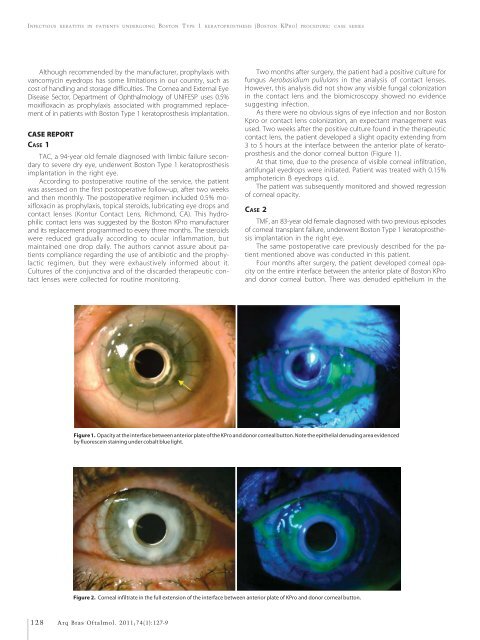a rquivos b rasileiros - Conselho Brasileiro de Oftalmologia
a rquivos b rasileiros - Conselho Brasileiro de Oftalmologia
a rquivos b rasileiros - Conselho Brasileiro de Oftalmologia
You also want an ePaper? Increase the reach of your titles
YUMPU automatically turns print PDFs into web optimized ePapers that Google loves.
INFECTIOUS KERATITIS IN PATIENTS UNDERGOING BOSTON TYPE 1 KERATOPROSTHESIS (BOSTON KPRO) PROCEDURE: CASE SERIES<br />
Although recommen<strong>de</strong>d by the manufacturer, prophylaxis with<br />
vancomycin eyedrops has some limitations in our country, such as<br />
cost of handling and storage difficulties. The Cornea and External Eye<br />
Disease Sector, Department of Ophthalmology of UNIFESP uses 0.5%<br />
moxifloxacin as prophylaxis associated with programmed replacement<br />
of in patients with Boston Type 1 keratoprosthesis implantation.<br />
CASE REPORT<br />
CASE 1<br />
TAC, a 94-year old female diagnosed with limbic failure secondary<br />
to severe dry eye, un<strong>de</strong>rwent Boston Type 1 keratoprosthesis<br />
implantation in the right eye.<br />
According to postoperative routine of the service, the patient<br />
was assessed on the first postoperative follow-up, after two weeks<br />
and then monthly. The postoperative regimen inclu<strong>de</strong>d 0.5% moxifloxacin<br />
as prophylaxis, topical steroids, lubricating eye drops and<br />
contact lenses (Kontur Contact Lens, Richmond, CA). This hydrophilic<br />
contact lens was suggested by the Boston KPro manufacturer<br />
and its replacement programmed to every three months. The steroids<br />
were reduced gradually according to ocular inflammation, but<br />
maintained one drop daily. The authors cannot assure about patients<br />
compliance regarding the use of antibiotic and the prophylactic<br />
regimen, but they were exhaustively informed about it.<br />
Cultures of the conjunctiva and of the discar<strong>de</strong>d therapeutic contact<br />
lenses were collected for routine monitoring.<br />
Two months after surgery, the patient had a positive culture for<br />
fungus Aerobasidium pullulans in the analysis of contact lenses.<br />
However, this analysis did not show any visible fungal colonization<br />
in the contact lens and the biomicroscopy showed no evi<strong>de</strong>nce<br />
suggesting infection.<br />
As there were no obvious signs of eye infection and nor Boston<br />
Kpro or contact lens colonization, an expectant management was<br />
used. Two weeks after the positive culture found in the therapeutic<br />
contact lens, the patient <strong>de</strong>veloped a slight opacity extending from<br />
3 to 5 hours at the interface between the anterior plate of keratoprosthesis<br />
and the donor corneal button (Figure 1).<br />
At that time, due to the presence of visible corneal infiltration,<br />
antifungal eyedrops were initiated. Patient was treated with 0.15%<br />
amphotericin B eyedrops q.i.d.<br />
The patient was subsequently monitored and showed regression<br />
of corneal opacity.<br />
CASE 2<br />
TMF, an 83-year old female diagnosed with two previous episo<strong>de</strong>s<br />
of corneal transplant failure, un<strong>de</strong>rwent Boston Type 1 keratoprosthesis<br />
implantation in the right eye.<br />
The same postoperative care previously <strong>de</strong>scribed for the patient<br />
mentioned above was conducted in this patient.<br />
Four months after surgery, the patient <strong>de</strong>veloped corneal opacity<br />
on the entire interface between the anterior plate of Boston KPro<br />
and donor corneal button. There was <strong>de</strong>nu<strong>de</strong>d epithelium in the<br />
Figure 1. Opacity at the interface between anterior plate of the KPro and donor corneal button. Note the epithelial <strong>de</strong>nuding area evi<strong>de</strong>nced<br />
by fluorescein staining un<strong>de</strong>r cobalt blue light.<br />
Figure 2. Corneal infiltrate in the full extension of the interface between anterior plate of KPro and donor corneal button.<br />
128 Arq Bras Oftalmol. 2011;74(1):127-9

















